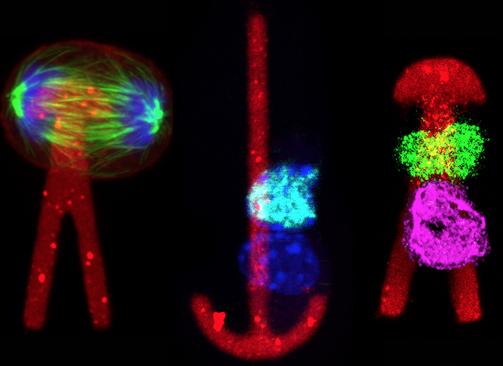Researchers from the Institut Pasteur, CEA and CNRS have discovered that the immediate environment of stem cells can have a strong influence on the fate of their descendants. The researchers observed that the forces applied to stem cells during division influenced the likelihood that these dividing cells would produce two new stem cells, one stem cell and one specialized cell, or even two specialized cells. This study has major implications for the therapeutic use of stem cells: it suggests that, by controlling the composition and conditions in the microenvironment of the niche, it is possible to reproduce and retain stem cell properties in culture for subsequent use in transplants to repair damaged tissues.
Press release
Paris, May 23, 2014

Following injury, stem cells in the organism are able to enter a process in which they divide and generate specialized daughter cells, known as differentiated cells. The aim of this process is to repair damaged tissue. Researchers in the Stem Cells and Development Unit (Institut Pasteur/CNRS), led by Shahragim Tajbakhsh, are focusing particularly on adult skeletal muscle stem cells in mice.
During skeletal muscle regeneration, stem cells are able to adopt one of two cell division processes: "symmetric" division, which generates cells of the same type - either two stem cells or two differentiated cells; or "asymmetric" division, where one stem cell and one differentiated cell are produced. In the latter case, the original DNA strands present in the mother stem cell may be transferred either randomly to the two daughter cells, or to one daughter cell, whereas the second daughter will inherit newly synthesized DNA strands. This phenomenon is known as "biased" DNA segregation. Although the role of this process is not yet fully understood, it has been suggested that distributing the DNA strands selectively in this manner might play a role in determining cell fate. In other words, the type of DNA inherited by a daughter cell - either original or copied - determines whether it will be a stem cell or a specialized cell.
The balance between symmetric and asymmetric division is fundamental: it ensures both the generation of specialized cells, which are essential to the regeneration process, and the presence of a constant pool of stem cells. However, until now little information has been available about the mechanisms governing DNA segregation and cell fates.
To provide additional insights, the researchers investigated the influence of the external forces applied to a cell in its natural environment, in the tissues of the organism. To mimic this process, they used "micropattern" technologies specifically designed by the Institute of Life Sciences Research and Technologies (CEA iRTS V). These micropatterns, which are arranged in various shapes (round, square, single or double anchor, etc.) a few square micrometers in size, can accomodate one or two cells. They are mounted on small slides, each slide containing several thousand patterns, then covered with a substrate which allows the cells to adhere only to the pattern. Each stem cell is deposited on a micropattern, which then serves to hold the cell in place during cell division thereby allowing the resulting two daughter cells to remain on the micropattern. By rearranging the shape of the micropattern and therefore the adhesion surface, it is possible to alter the forces experienced by the stem cell and to study the resulting consequences and the type of division.
The researchers observed that an asymmetric pattern triggers about 2.5 times more biased DNA segregation than a symmetric pattern. Furthermore, an asymmetric pattern also triggers four times more asymmetric divisions - giving a stem cell and a differentiated cell - than a symmetric pattern.
Asymmetric patterns give rise to asymmetric divisions and favor the combination of biased DNA segregation and the generation of two different daughter cells. Therefore, it appears that stem cell fates depend not only on internal cell signals but also to a large extent on external factors, and in particular the forces experienced by dividing cells.
Directing stem cell fates by manipulating the microenvironment opens the possibility to systematically investigate the role of extracellular matrix molecules and their influence on stem cell fates. This work has major implications in the context of the therapeutic use of stem cells: it may be possible to produce cells with specific potentials to meet specific needs, and then transplant them for efficient tissue or organ regeneration. The researchers are now examining the composition of the stem cell niche with the hope of reproducing these conditions in culture to optimize the control of stem cell fate.
Illustration: Figure 1: a stem cell dividing on an asymmetric micropattern (red). Figure 2: following asymmetric division, one daughter cell has received the original DNA (dark blue) and the other a DNA copy (light blue). Figure 3: asymmetric division has produced a daughter stem cell (green) and a differentiated daughter cell (pink). Copyright Institut Pasteur.
Source
Cell adhesion geometry regulates non-random DNA segregation and asymmetric cell fates in mouse skeletal muscle stem cells. Cell Reports, May 15, 2014.
Siham Yennek (1,2), Mithila Burute (3,4,5), Manuel Théry (3,5) and Shahragim Tajbakhsh (1)
- Institut Pasteur, Stem Cells & Development, Department of Developmental & Stem Cell Biology, CNRS URA 2578, 25 rue du Dr. Roux, Paris, F-75015;
- Sorbonne Universities, UPMC Univ Paris 06, IFD-ED 515, 4 Place Jussieu, 75252 Paris Cedex 05, France;
- Institute of Life Sciences Research and Technologies, UMR5168, CEA/UJF/INRA/CNRS, 17 rue des Martyrs, 38054, Grenoble, France;
- CYTOO SA, 7 Parvis Louis Néel, BP50 38040, Grenoble, France;
- Saint Louis Hospital, University Hematology Institute, U1160, INSERM/AP-HP/ Paris Diderot University, 1 Avenue Claude Vellefaux, Paris, 75010, France.
Contact
Institut Pasteur Press Office
Marion Doucet – marion.doucet@pasteur.fr - +33 (0)1 45 68 89 28
Nadine Peyrolo - nadine.peyrolo@pasteur.fr - +33 (0)1 45 68 81 47



